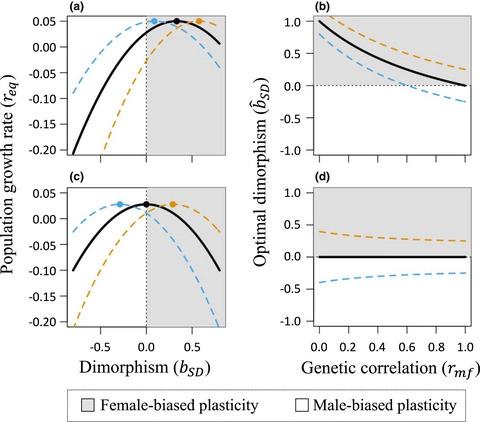当前位置:
X-MOL 学术
›
Ecol. Lett.
›
论文详情
Our official English website, www.x-mol.net, welcomes your
feedback! (Note: you will need to create a separate account there.)
Sexual dimorphism in phenotypic plasticity and persistence under environmental change: An extension of theory and meta-analysis of current data
Ecology Letters ( IF 7.6 ) Pub Date : 2022-03-25 , DOI: 10.1111/ele.14005 Sandra Hangartner 1 , Carla M Sgrò 1 , Tim Connallon 1 , Isobel Booksmythe 1
Ecology Letters ( IF 7.6 ) Pub Date : 2022-03-25 , DOI: 10.1111/ele.14005 Sandra Hangartner 1 , Carla M Sgrò 1 , Tim Connallon 1 , Isobel Booksmythe 1
Affiliation

|
Populations must adapt to environmental changes to remain viable. Both evolution and phenotypic plasticity contribute to adaptation, with plasticity possibly being more important for coping with rapid change. Adaptation is complex in species with separate sexes, as the sexes can differ in the strength or direction of natural selection, the genetic basis of trait variation, and phenotypic plasticity. Many species show sex differences in plasticity, yet how these differences influence extinction susceptibility remains unclear. We first extend theoretical models of population persistence in changing environments and show that persistence is affected by sexual dimorphism for phenotypic plasticity, trait genetic architecture, and sex-specific selection. Our models predict that female-biased adaptive plasticity—particularly in traits with modest-to-low cross-sex genetic correlations—typically promotes persistence, though we also identify conditions where sexually monomorphic or male-biased plasticity promotes persistence. We then perform a meta-analysis of sex-specific plasticity under manipulated thermal conditions. Although examples of sexually dimorphic plasticity are widely observed, systematic sex differences are rare. An exception—cold resistance—is systematically female-biased and represents a trait wherein sexually dimorphic plasticity might elevate population viability in changing environments. We discuss our results in light of debates about the roles of evolution and plasticity in extinction susceptibility.
中文翻译:

环境变化下表型可塑性和持久性的性别二态性:理论的扩展和当前数据的荟萃分析
人口必须适应环境变化才能保持生存。进化和表型可塑性都有助于适应,可塑性对于应对快速变化可能更为重要。具有不同性别的物种的适应是复杂的,因为性别在自然选择的强度或方向、性状变异的遗传基础和表型可塑性方面可能不同。许多物种在可塑性方面表现出性别差异,但这些差异如何影响灭绝易感性仍不清楚。我们首先扩展了不断变化的环境中种群持久性的理论模型,并表明持久性受到表型可塑性、性状遗传结构和性别特异性选择的性别二态性的影响。我们的模型预测,女性偏向的适应性可塑性——特别是在具有中到低跨性别遗传相关性的特征中——通常会促进持久性,尽管我们也确定了性单态性或男性偏向的可塑性促进持久性的条件。然后,我们在受控的热条件下对性别特异性可塑性进行荟萃分析。尽管广泛观察到两性可塑性的例子,但系统性的性别差异很少见。一个例外——耐寒性——系统性地偏向于女性,并且代表了一种特征,其中性二态可塑性可能会在不断变化的环境中提高种群的生存能力。我们根据关于进化和可塑性在灭绝易感性中的作用的辩论来讨论我们的结果。尽管我们还确定了性单态性或男性偏向可塑性促进持久性的条件。然后,我们在受控的热条件下对性别特异性可塑性进行荟萃分析。尽管广泛观察到两性可塑性的例子,但系统性的性别差异很少见。一个例外——耐寒性——系统性地偏向于女性,并且代表了一种特征,其中性二态可塑性可能会在不断变化的环境中提高种群的生存能力。我们根据关于进化和可塑性在灭绝易感性中的作用的辩论来讨论我们的结果。尽管我们还确定了性单态性或男性偏向可塑性促进持久性的条件。然后,我们在受控的热条件下对性别特异性可塑性进行荟萃分析。尽管广泛观察到两性可塑性的例子,但系统性的性别差异很少见。一个例外——耐寒性——系统性地偏向于女性,并且代表了一种特征,其中性二态可塑性可能会在不断变化的环境中提高种群的生存能力。我们根据关于进化和可塑性在灭绝易感性中的作用的辩论来讨论我们的结果。尽管广泛观察到两性可塑性的例子,但系统性的性别差异很少见。一个例外——耐寒性——系统性地偏向于女性,并且代表了一种特征,其中性二态可塑性可能会在不断变化的环境中提高种群的生存能力。我们根据关于进化和可塑性在灭绝易感性中的作用的辩论来讨论我们的结果。尽管广泛观察到两性可塑性的例子,但系统性的性别差异很少见。一个例外——耐寒性——系统性地偏向于女性,并且代表了一种特征,其中性二态可塑性可能会在不断变化的环境中提高种群的生存能力。我们根据关于进化和可塑性在灭绝易感性中的作用的辩论来讨论我们的结果。
更新日期:2022-03-25
中文翻译:

环境变化下表型可塑性和持久性的性别二态性:理论的扩展和当前数据的荟萃分析
人口必须适应环境变化才能保持生存。进化和表型可塑性都有助于适应,可塑性对于应对快速变化可能更为重要。具有不同性别的物种的适应是复杂的,因为性别在自然选择的强度或方向、性状变异的遗传基础和表型可塑性方面可能不同。许多物种在可塑性方面表现出性别差异,但这些差异如何影响灭绝易感性仍不清楚。我们首先扩展了不断变化的环境中种群持久性的理论模型,并表明持久性受到表型可塑性、性状遗传结构和性别特异性选择的性别二态性的影响。我们的模型预测,女性偏向的适应性可塑性——特别是在具有中到低跨性别遗传相关性的特征中——通常会促进持久性,尽管我们也确定了性单态性或男性偏向的可塑性促进持久性的条件。然后,我们在受控的热条件下对性别特异性可塑性进行荟萃分析。尽管广泛观察到两性可塑性的例子,但系统性的性别差异很少见。一个例外——耐寒性——系统性地偏向于女性,并且代表了一种特征,其中性二态可塑性可能会在不断变化的环境中提高种群的生存能力。我们根据关于进化和可塑性在灭绝易感性中的作用的辩论来讨论我们的结果。尽管我们还确定了性单态性或男性偏向可塑性促进持久性的条件。然后,我们在受控的热条件下对性别特异性可塑性进行荟萃分析。尽管广泛观察到两性可塑性的例子,但系统性的性别差异很少见。一个例外——耐寒性——系统性地偏向于女性,并且代表了一种特征,其中性二态可塑性可能会在不断变化的环境中提高种群的生存能力。我们根据关于进化和可塑性在灭绝易感性中的作用的辩论来讨论我们的结果。尽管我们还确定了性单态性或男性偏向可塑性促进持久性的条件。然后,我们在受控的热条件下对性别特异性可塑性进行荟萃分析。尽管广泛观察到两性可塑性的例子,但系统性的性别差异很少见。一个例外——耐寒性——系统性地偏向于女性,并且代表了一种特征,其中性二态可塑性可能会在不断变化的环境中提高种群的生存能力。我们根据关于进化和可塑性在灭绝易感性中的作用的辩论来讨论我们的结果。尽管广泛观察到两性可塑性的例子,但系统性的性别差异很少见。一个例外——耐寒性——系统性地偏向于女性,并且代表了一种特征,其中性二态可塑性可能会在不断变化的环境中提高种群的生存能力。我们根据关于进化和可塑性在灭绝易感性中的作用的辩论来讨论我们的结果。尽管广泛观察到两性可塑性的例子,但系统性的性别差异很少见。一个例外——耐寒性——系统性地偏向于女性,并且代表了一种特征,其中性二态可塑性可能会在不断变化的环境中提高种群的生存能力。我们根据关于进化和可塑性在灭绝易感性中的作用的辩论来讨论我们的结果。











































 京公网安备 11010802027423号
京公网安备 11010802027423号